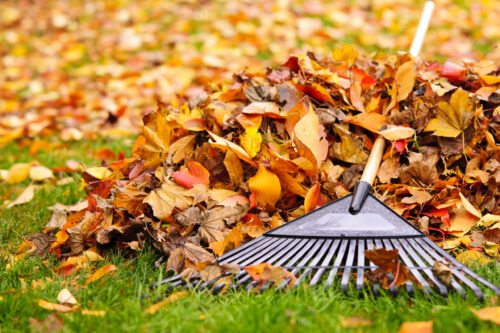Enchanting fall foliage is often followed by frost, and if the leaves that adorn your lawn are starting to turn golden, that means it’s time to prepare for the cold. Adjusting your lawn care strategy in the fall can help ensure that your nearly year-long efforts won’t go to waste when the temperature starts to drop and sleet and snow set in.
What do you need to change? Actually, not that much. You’ll basically continue to do exactly what you’ve been doing but make some slight adjustments. Follow along as we guide you through some fall lawn care tips for beginners that’ll leave your lawn in dazzling condition to debut in the spring all fresh and new.
Remove Leaves Consistently
While piles of golden leaves often make for fantastic photo backdrops, they’re not so great for the health of your lawn. As you might imagine, they block sunlight and trap in moisture, creating dark, damp conditions for your soil underneath to provide the right nutrients to your grass. Grab your gloves, a rake and a few trash bags about once a week during autumn months and make a habit out of raking and clearing away leaves so that sunlight can reach your grass.
Adjust Your Mower Height
Grass grows up until about the first frost, so you’ll still need to mow your lawn during the fall. However, you might not need to mow it as often and you’ll definitely need to adjust your mower height. The ideal height for your lawn will depend on the type of grass that you have, but it’s usually between about two to three inches. If you’re cutting it too short, you’ll damage the root system, and if you let it grow too long, it’ll be more vulnerable to snowy mold once the cold weather arrives.
Fertilize in Early Fall
When’s the best time to fertilize your lawn in the fall? Near the beginning of the season and then once again about six to eight weeks later. Seeing as your lawn’s root system was likely damaged by the dry summer heat, fertilizing it at the beginning of the fall is a great way to blast it with a hit of nutrients so that it has time to rebuild before winter. Six to eight weeks later, fertilize it again with winter guard lawn food that’ll allow your lawn to store up nutrients to stay healthy throughout the winter.
Clean Your Tools
Now’s the time to clean all of your tools, including your lawn mower, cutting tools and more. Doing so now will help prevent them from rusting when they’re stored in your garage or shed all winter long, thus protecting your investment and allowing you to enjoy fresh, clean tools for spring lawn care. If the first frost has already nipped your nose (and your lawn’s), you’ll likely be storing your lawnmower away, too. Be sure to give it some pre-winter maintenance before stashing it away.
Don’t Skimp on the Watering
Yes, you still have to water your lawn in the fall! Even if you live in an area where it’s getting colder in September and October, you still need to keep watering your lawn. It should be getting about an inch of water each week. As a rule of thumb, you can usually bet on having to water your lawn throughout October. After that, it’s typically safe to flush your irrigation system and winterize your pipes to prevent them from bursting in the colder weather.
Have Fall Lawn Care Questions?
If you’re still not how to go about engaging in fall lawn care prep, it’s best to ask a trusted lawn care expert. From finding the right kind of fertilizer for your lawn to ensuring that your irrigation system is prepped for winter freeze, they’ll be able to guide you through the steps to help you protect your lawn throughout every season of the year.
About Weld-On
Weld-On Adhesives, Inc., a subsidiary of IPS Corporation, is the pioneer and leading manufacturer of Weld-On® solvent cements, primers and cleaners for PVC, CPVC, ABS and other plastic piping systems. Weld-On products are globally recognized as the premium products for joining plastic pipes and fittings. Headquartered in California, Weld-On has state-of-the-art operations throughout the United States, as well as China, and a worldwide network of sales representatives and distributors.

